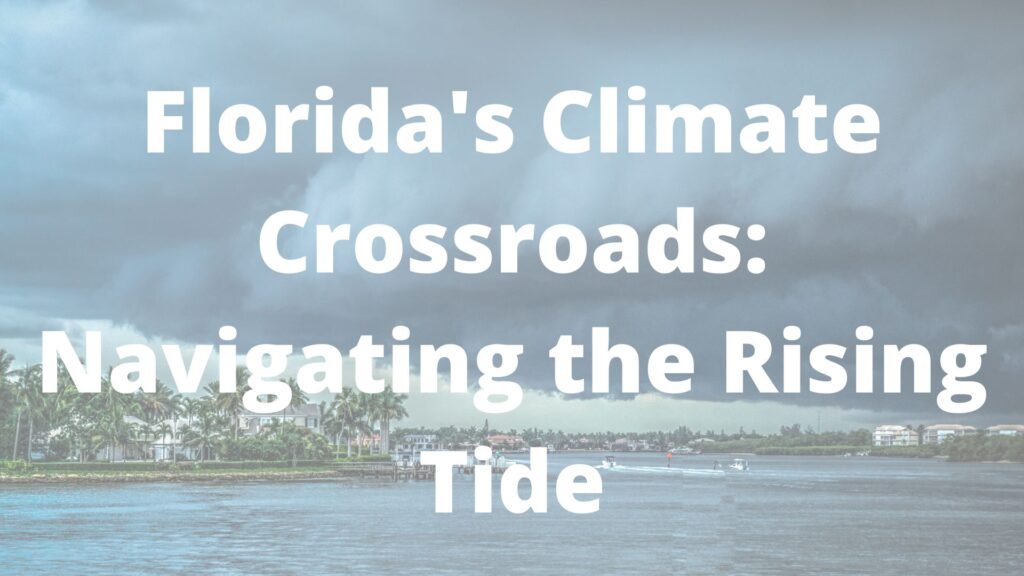
The Florida State University Climate Center’s article on climate change outlines the scientific consensus that the Earth’s climate is warming unequivocally due to human activities, primarily the emission of greenhouse gases. The article emphasizes the observed changes, including rising global temperatures, alterations in precipitation patterns, increasing frequency and intensity of extreme weather events (like hurricanes and heatwaves), and, critically for Florida, rising sea levels.
It details the causes of climate change, focusing on the combustion of fossil fuels and deforestation, which increase atmospheric concentrations of carbon dioxide and other heat-trapping gases. The article also discusses the impacts of these changes on various sectors, including human health, agriculture, water resources, and natural ecosystems.
Specifically, regarding Florida, the article highlights the state’s vulnerability to sea-level rise due to its low-lying coastal geography. It explains that rising sea levels lead to increased coastal erosion, saltwater intrusion into freshwater sources, and more frequent and severe flooding, threatening infrastructure, ecosystems like the Everglades, and coastal communities. The article underscores the need for both mitigation (reducing greenhouse gas emissions) and adaptation (adjusting to the unavoidable changes) strategies to address the challenges posed by climate change in Florida.
While construction itself can contribute to carbon emissions through material production and processes, innovative and strategic construction practices can play a significant role in adapting to and mitigating the impacts of rising sea levels in Florida:
- Elevated Construction: Building new structures and elevating existing ones above projected flood levels is a crucial adaptation strategy. This includes raising homes, businesses, and critical infrastructure like roads and power stations on pilings, stilts, or engineered fill.
- Resilient Infrastructure: Designing and constructing infrastructure (bridges, seawalls, drainage systems) with greater resilience to flooding, storm surge, and saltwater intrusion is essential. This involves using durable, water-resistant materials and incorporating flexible designs that can withstand increased stress.
- Living Shorelines: Instead of traditional hard infrastructure like concrete seawalls, constructing “living shorelines” using natural materials like oyster reefs, mangroves, and salt marshes can provide natural flood protection, reduce erosion, enhance biodiversity, and even sequester carbon. These nature-based solutions work with natural processes to buffer coastal areas.
- Improved Drainage and Water Management: Constructing more efficient and robust drainage systems, including natural infrastructure like swales and permeable pavements, can help manage increased rainfall and reduce localized flooding associated with rising sea levels. Implementing green infrastructure principles in urban development can also help absorb and filter storm water.
- Sustainable Materials and Construction Practices: Utilizing low-carbon building materials, reducing construction waste, and employing energy-efficient construction techniques can help mitigate the overall contribution of the construction sector to greenhouse gas emissions, addressing the root cause of climate change.
- Strategic Relocation and Deconstruction: In highly vulnerable areas, construction efforts might involve the strategic relocation of critical infrastructure and the responsible deconstruction of buildings in areas projected to be permanently inundated. This requires careful planning and community engagement.
- Innovative Building Technologies: Research and implementation of innovative building technologies, such as amphibious foundations that allow structures to float during floods, could offer long-term solutions for adapting to rising waters.
While the construction industry has a role to play in reducing its carbon footprint, its expertise and innovation are vital for developing and implementing the adaptation strategies necessary to protect Florida’s coastal communities and infrastructure from the growing threat of rising sea levels. This requires a shift towards more resilient, nature-based, and forward-thinking construction practices.
John Caravella Esq., is a construction attorney and formerly practicing project architect at The Law Office of John Caravella, P.C., representing architects, engineers, contractors, subcontractors, and owners in all phases of contract preparation, litigation, and arbitration across New York and Florida. He also serves as an arbitrator to the American Arbitration Association Construction Industry Panel. Mr. Caravella can be reached by email: [email protected] or (631) 608-1346.
The information provided on this website does not, and is not intended to, constitute legal advice; instead, all information, content, and materials available on this site are for general informational purposes only. Readers of this website should contact their attorney to obtain advice with respect to any particular legal matter. No reader, user, or browser of this site should act or refrain from acting on the basis of information on this site without first seeking legal advice from counsel in the relevant jurisdiction. Only your individual attorney can provide assurances that the information contained herein – and your interpretation of it – is applicable or appropriate to your particular situation. Use of, and access to, this website or any of the links or resources contained within the site do not create an attorney-client relationship between the reader, user, or browser and website authors, contributors, contributing law firms, or committee members and their respective employers.

